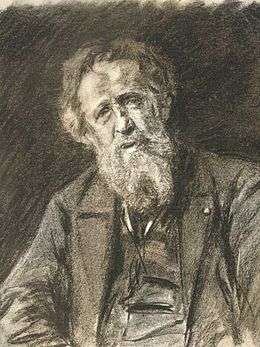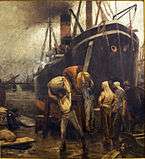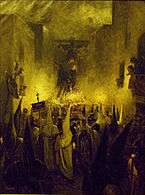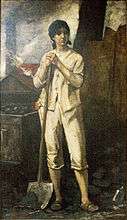Constantin Meunier
| Constantin Meunier | |
|---|---|
 | |
| Born |
12 April 1831 Etterbeek, Belgium |
| Died |
4 April 1905 (aged 73) Brussels, Belgium |
| Nationality | Belgium |
| Occupation | Painter, sculptor |


Constantin Meunier (12 April 1831, Brussels – 4 April 1905, Ixelles) was a Belgian painter and sculptor. He made an important contribution to the development of modern art by elevating the image of the industrial worker, docker and miner to an icon of modernity. His work is a reflection of the industrial, social and political developments of his day and represents a compassionate and committed view of man and the world.[1]
Life
Constantin Meunier was born in the traditionally working-class area of Etterbeek in Brussels. He was encouraged to pursue an artistic career by his elder brother, the engraver Jean-Baptiste Meunier (1821–1900). He entered the Academy of Fine Arts in Brussels in September 1845. He studied under the sculptor Louis Jehotte (1804–84) from 1848. He also attended from 1852 the private studio of the sculptor Charles-Auguste Fraikin.[2]
Art career
His first exhibit was a plaster sketch, The Garland, shown at the Brussels Salon in 1851. Soon afterwards, on the advice of the painter Charles de Groux}, he abandoned the chisel for the brush. His first important painting, The Salle St Roch (1857), was followed by a series of paintings including A Trappist Funeral (1860), Trappists Ploughing (1863), in collaboration with Alfred Verwee, Divine Service at the Monastery of La Trappe (1871) and episodes of the German Peasants' War (1878), as well as of Belgium's own historical Peasants' War.
About 1880 he was commissioned to illustrate those parts of Camille Lemonnier's description of Belgium in Le Tour du monde which referred to miners and factory-workers, and produced In the Factory, Smithery at Cockerill's, Melting Steel at the Factory at Seraing (1882), Returning from the Pit, and The Broken Crucible (1884).
In 1882 he was employed by the government to copy Pedro de Campaña's Descent from the Cross at Seville, and in Spain he painted such characteristic pictures as The Café Concert, Procession on Good Friday, and The Tobacco Factory at Seville (Brussels Gallery). On his return to Belgium he was appointed professor at the Louvain Academy of Fine Arts.
In 1885 he returned to sculpture and produced The Puddler, The Hammerer (1886), Firedamp (1889, Brussels Gallery), Le Débardeur (modeled 1885; many castings made 1889–1905), Ecce Homo (1891), The Old Mine-Horse (1891), The Mower (1892), The Glebe (1892), the monument to Father Damien at Louvain (1893), Puddler at the Furnace (1893), the scheme of decoration for the Botanical Garden of Brussels in collaboration with the sculptor Charles van der Stappen (1893), The Horse at the Pond, in the square in the north-east quarter of Brussels, and two unfinished works, the Monument to Labour and the Émile Zola monument, in collaboration with the French sculptor Alexandre Charpentier.
The Monument to Labour, which was acquired by the State for the Brussels Gallery, comprises four stone bas-reliefs: Industry, The Mine, Harvest, and the Harbour; four bronze statues: The Sower, The Smith, The Miner, and the Ancestor; and a bronze group, Maternity.
He was one of the co-founders of the Société Libre des Beaux-Arts of Brussels and was a member of the International Society of Sculptors, Painters and Gravers.[3]
Freemasonary
He was a freemason, and a member of the lodge Les Amis Philanthropes of the Grand Orient of Belgium in Brussels.
Death
Meunier died in Brussels on 4 April 1905.
Works by Constantin Meunier
- Paintings
 The Return of the Miners
The Return of the Miners Potato diggers
Potato diggers Tobacco Factory, Sevilla
Tobacco Factory, Sevilla Café del Buzero, Sevilla
Café del Buzero, Sevilla The Harbour
The Harbour Procession of Silence, Sevilla
Procession of Silence, Sevilla Portrait of Jeanne Meunier
Portrait of Jeanne Meunier Coal miner
Coal miner
- Sculptures
- The sower
 The Dock Worker
The Dock Worker The Horse at the Pond 1899
The Horse at the Pond 1899- Man Battling with the Elements
Museum collections
In 1939, the Musée Constantin-Meunier dedicated to his work was opened in the last house in which Meunier lived and worked, in Ixelles, Brussels. Today about 150 of his works are displayed there.[4] M - Museum Leuven also holds a number of important works by Meunier,[5] as does Brussels' Fin-de-Siècle Museum.
See also
References
- ↑ Constantin Meunier (1831-1905) Retrospective
- ↑ Pierre Baudson. "Meunier, Constantin." Grove Art Online. Oxford Art Online. Oxford University Press. Web. 6 Mar. 2016
- ↑ "The International Society of Sculptors, Painters and Gravers". Mapping the Practice and Profession of Sculpture in Britain and Ireland 1851-1951. Glasgow University. Retrieved 31 May 2013.
- ↑ "Constantin Meunier Museum". Belgian Tourist Office (Brussels-Wallonia). Archived from the original on 12 May 2013. Retrieved 9 April 2013.
- ↑ Meunier in Leuven at M - Museum Leuven
Sources

- P. & V. Berko, "Dictionary of Belgian painters born between 1750 & 1875", Knokke 1981, pp. 466–467.
External links
- Works by or about Constantin Meunier at Internet Archive

- Works of Constantin Meunier at the Museum of Modern Art, Brussels
- The Constantin Meunier Museum, Brussels